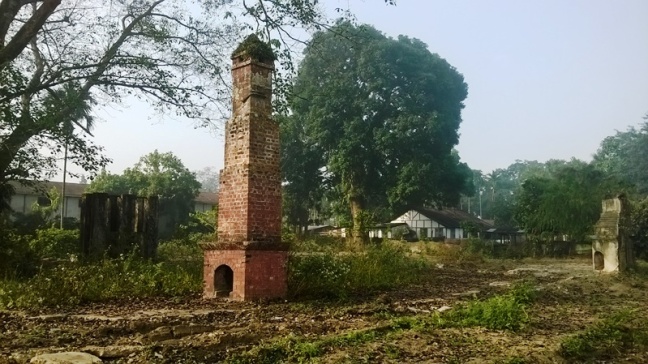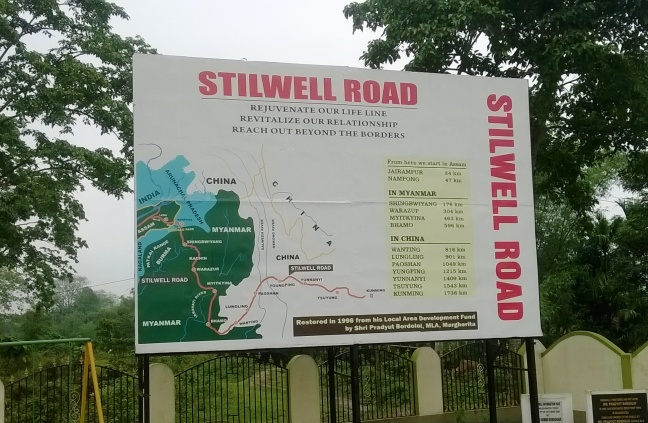
The period of 1939 to 1945 was one of the darkest moments in the history of mankind. It was during this period the world witnessed the Second World War – a state of ‘total war’ where the major participants threw their entire economic, industrial, and scientific capabilities behind the war effort, erasing the distinction between civilian and military resources. This war brought down the major super powers of the period into ashes. Japan was rocked with the mighty nuclear explosion of Hiroshima and Nagasaki and it was after the Second World War that the world realized the might of the Americans!
On our journey to bring forth to the World the lost history of the State of Assam and it’s connection with the World during the World War II, we reached the banks of the River Dehing at the tinsel town of Margherita in the north eastern region of India. Our curiosity and interest this time was to find the remains of the 20th General Hospital that was built during the World War II to treat the sick and wounded American soldiers who were on the mission to built one of the most challenging roads across the dense jungles of the Dehing Patkai – the Stilwell (Ledo) Road. The Stilwell Road was built in 1942 under the able guidance of Major General Vinegar Joe Stilwell of the U S Army and its purpose was to restore communication with China after the Imperial Japanese Army had cut supply across the Burma Road. At the time of the War, the engineers of the American army were desperately cutting this new route also called the Ledo Road across the Patkai Mountains for the supply of armed troops, military supplies and food. They had to fight the Japanese resistance as well as bulldoze their way across the dense jungles of the Patkai Mountain Range. Injuries and Casulaities were common and the wounded were brought back to Margherita where they were treated at the 20th General Hospital. The hospital also cared for Chinese soldiers who were serving as screen when the road was pushed forward.
The 20th General Hospital was formed in 1940 when the Dean of the School of Medicine at the University of Pennsylvania (Penn) was asked by the Surgeon General of the United States to organize an Army hospital unit to care for the Allied wounded in the Burma-India theater. But, the unit did not receive orders to leave for Camp Clairbone, Louisiana, until May 15, 1942. It was in March 1943 that the team of qualified doctors and nurses reached Margherita.
When the staff members of the 20th General first arrived in Margherita, there were only three small buildings with concrete floors, tin roofs and open fronts, as well as a group of bamboo huts with dirt floors and lights showing through thatched roofs. But, when the hospital was finally built fully several months later, it had transformed into a first-rate 2500-bed hospital, with 148 buildings covering one and half square miles. It became the largest hospital in the China-India-Burma theater. It also received a rating of “Superior” – the highest possible in annual general inspections.
Approximately 110 nurses and 600 enlisted men comprised this University of Pennsylvania’s hospital unit. Colonel Elias Cooley, a regular Army officer and a graduate of Philadelphia’s Jefferson Medical College, was in command. Lieutenant Colonel Isidor Ravdin, Professor of Surgery at Penn and an authority on the use of blood plasma and sulfa drugs, was the head of the surgical service. Lieutenant Colonel Thomas Fitz-Hugh Jr., Clinical Professor of Medicine at Penn, headed the Medical Service. Most of the medic personnel were drawn from Penn faculty, and many of its nurses came from the Philadelphia General, Penn, Presbyterian, Episcopal and Bryn Mawr hospitals.
It was difficult for the Americans to acclimatize and perform well in a region with 120 inches of rainfall per year, humid summers and cold winters. However, with little paraphernalia and with none of the personal comforts to which they are accustomed, they were able to establish a complete hospital unit which contributed not only to the health of the Allied soldiers, but also to advancement of medical science. Beginning with a few shacks, they ended with a fully equipped modern hospital, provided with laboratories, x-ray and blood storage facilities and all other necessities of medical and surgical practice. It was filled almost from the beginning beyond its rated capacity of 1000 beds. At one time, it actually sheltered 2560 patients. During the entire period of activity, it received altogether 73,000 patients, with only a few more than 300 deaths form all cases.
Since the staff at the hospital had strong academic backgrounds, the hospital became a center for weekly professional conferences attended by American, British and Indian officers from other medical installations. Some 100 important medical papers and scientific reports were produced by the 20th General Hospital, including those on scrub typhus and ophthalmology.
The 20th General Hospital was cited by many for its outstanding work. These include Lord Louis Mountbatten, General Vinegar Joe Stillwell, the Commanding Generals of the 1st and the 6th Chinese Armies, etc. The hospital won praise and personal gratitude from Lord Louis Mountbatten. Mountbatten had suffered a painful and serious injury when a low-hanging section of dead bamboo struck him in the eye, causing a hemorrhage, as he drove a jeep along a jungle trail in the North Burma front. He was flown into the hospital where Dr. (Major) Harold Scheie performed delicate treatment to save his sight. Mountbatten lay flat on his back with his eyes bandaged for five days. Afterwards, Scheie accompanied the commander to Delhi and looked after ehe injured eye during the convalescent period. Mountbatten and Dr. Scheie (who died on March 5, 1990) became life long friends. It was Mountbatten who, in August 1972, dedicated the Scheie Eye Institute in Philadephia.
General Raymond Kelser of the Army Veterinary Corps reported to the US Surgeon General Norman Kirk that “the 20th General Hospital would be outstanding anywhere in the world and is the equal of university hospitals”.
As fighting receded from the Assam-Burma region, the Army began to withdraw officers and men needed in other fronts. The hospital closed its medical services in December, 1945, and was decommissioned on December 27.
Reference: ‘The Philadelphia – Margherita Connection’ – Mr. Jugal Kalita










Myanmar
